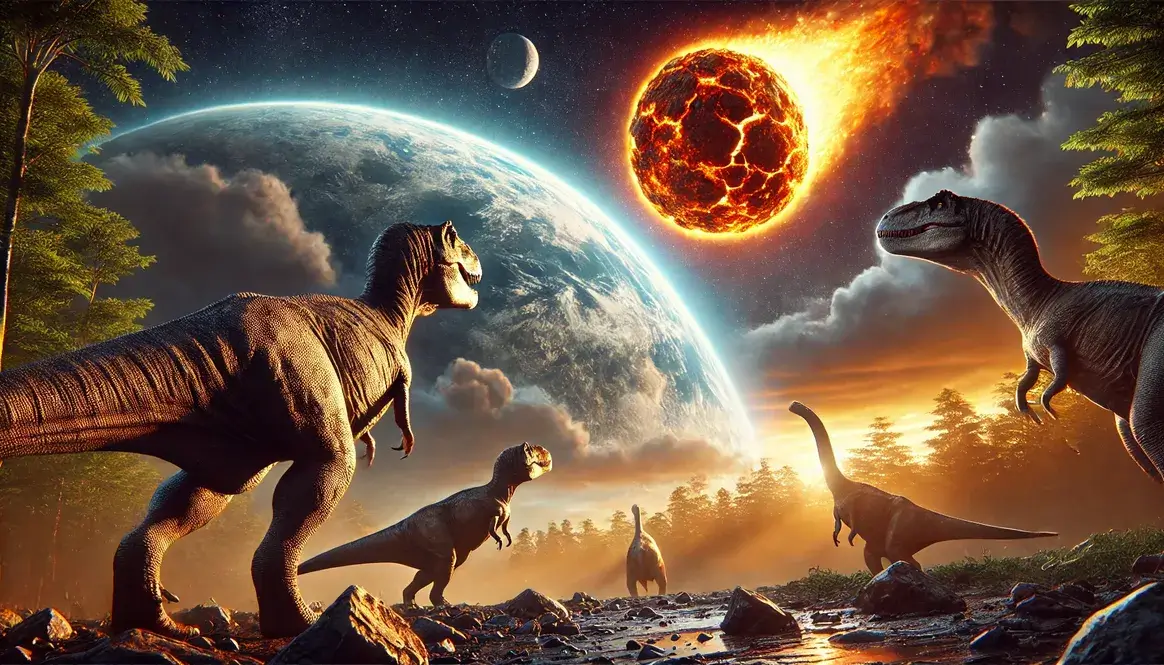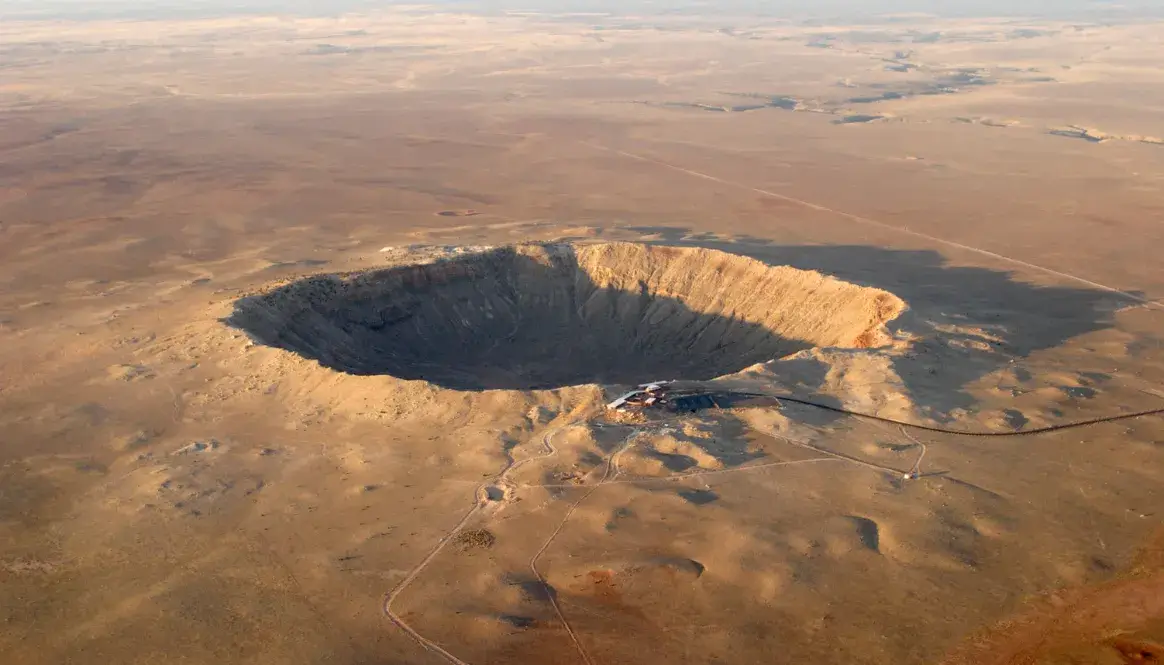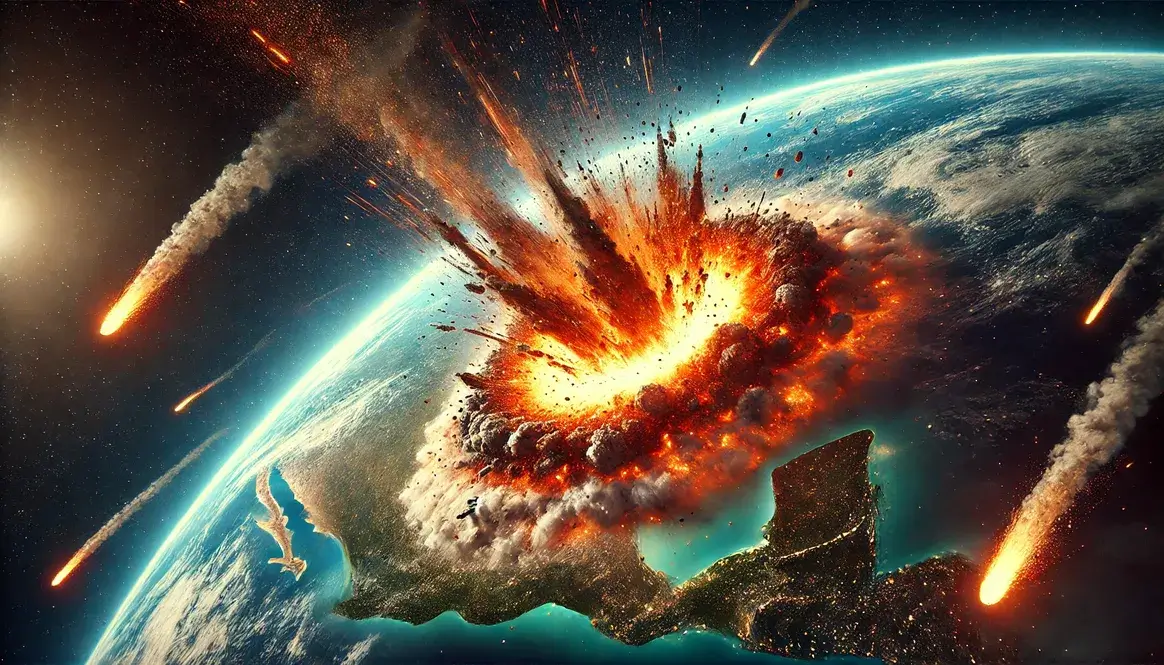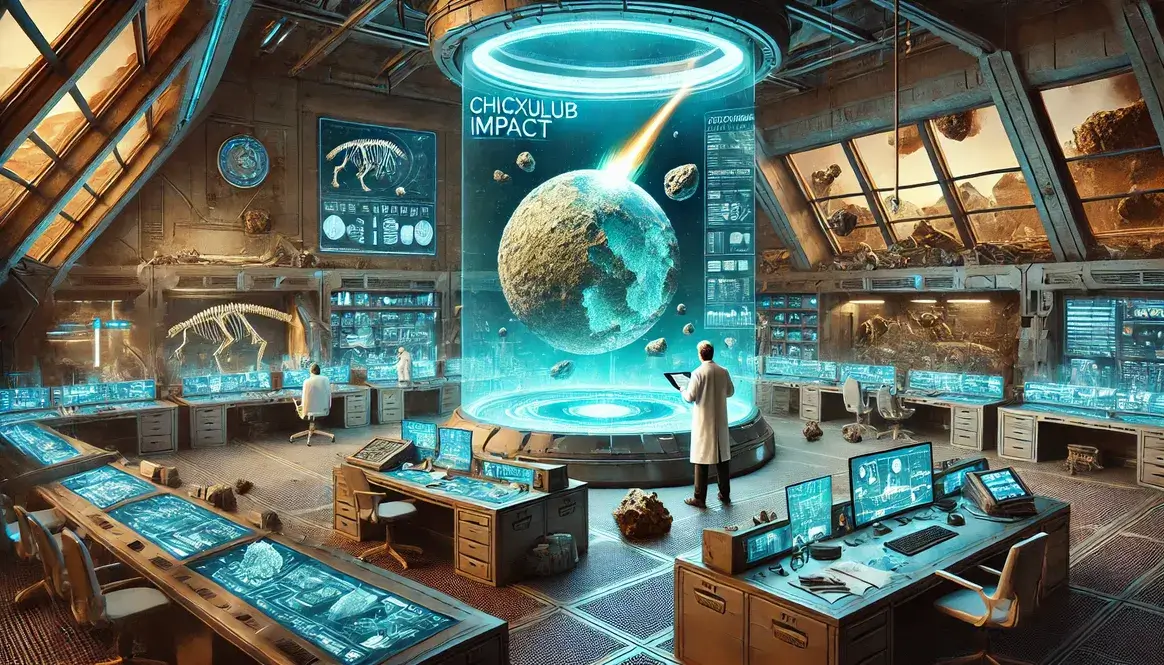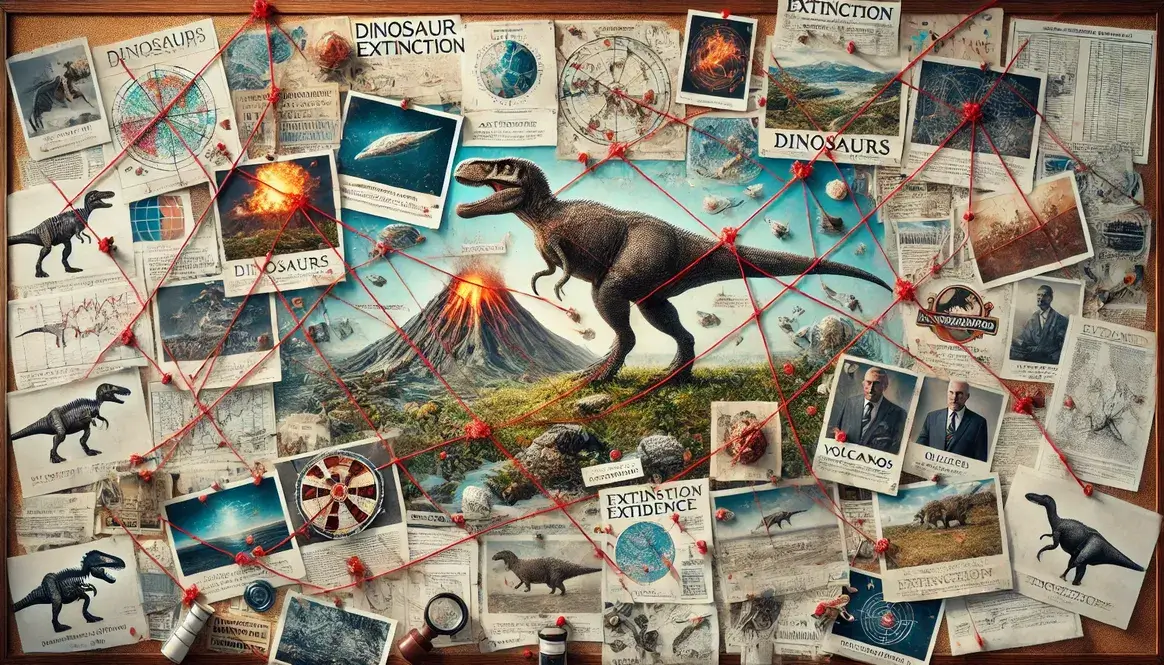The Birth of the Alvarez Asteroid Theory
The Alvarez asteroid theory shook the scientific world in 1980, offering a groundbreaking explanation for the disappearance of dinosaurs. This revolutionary idea came from an unlikely duo: Luis Alvarez, a Nobel Prize-winning physicist, and his son Walter, a geologist. Their collaboration would change our understanding of Earth’s history forever.
The Alvarez team didn’t set out to solve the mystery of dinosaur extinction. Instead, they stumbled upon a clue that would lead them down an unexpected path. Their journey began in the peaceful Italian countryside, far from the usual haunts of dinosaur hunters.
The Gubbio Clay Layer Discovery
In the late 1970s, Walter Alvarez was studying rock formations near the town of Gubbio, Italy. He noticed something odd: a thin layer of clay sandwiched between limestone rocks. This clay marked the boundary between the Cretaceous and Paleogene periods, known as the K-Pg boundary.
What made this clay layer special? It coincided with a massive die-off of sea creatures. Microscopic fossils were abundant below the clay but nearly absent above it. This abrupt change hinted at a catastrophic event that wiped out many species in a geological blink of an eye.
The Iridium Anomaly
The Alvarez team decided to analyze the chemical composition of the clay layer. What they found left them stunned. The clay contained an unusually high amount of iridium, a rare element on Earth’s surface but common in asteroids and comets.
This iridium spike was the key that unlocked the Alvarez asteroid theory. Here’s why it was so important:
- Rarity on Earth: Iridium is scarce in Earth’s crust but abundant in space rocks.
- Global presence: Similar iridium-rich layers were later found worldwide at the K-Pg boundary.
- Quantity: The amount of iridium suggested a massive asteroid impact.
| Element | Earth’s Crust (parts per billion) | Meteorites (parts per billion) |
|---|---|---|
| Iridium | 0.001 | 500 |
Table: Iridium concentration in Earth’s crust vs. meteorites
The Alvarez team proposed a bold idea: a giant asteroid, about 10 kilometers wide, had slammed into Earth 66 million years ago. This cosmic collision released an enormous amount of energy, equivalent to billions of atomic bombs, and spread iridium-rich dust globally.
This hypothesis explained not only the iridium anomaly but also provided a mechanism for the mass extinction that wiped out the dinosaurs. The Alvarez asteroid theory linked the worlds of geology, chemistry, and paleontology in a way never seen before.
As we delve deeper into the evidence supporting this theory, we’ll see how it revolutionized our understanding of Earth’s history and the forces that shape life on our planet.
Key Evidence Supporting the Alvarez Hypothesis
The Alvarez asteroid theory didn’t just rely on the iridium anomaly. As scientists dug deeper, they uncovered more clues that strengthened the case for a massive impact event. Let’s explore the key pieces of evidence that support this groundbreaking hypothesis.
Global Iridium Layer
After the initial discovery in Gubbio, scientists around the world started looking for similar iridium-rich layers. To their amazement, they found them everywhere they looked!
From Denmark to New Zealand, from the depths of the ocean to mountain tops, the iridium-rich layer showed up at the K-Pg boundary. This global distribution was crucial because it suggested a worldwide event, not just a local phenomenon.
Here’s why the global iridium layer is so important:
- Consistency: The layer appeared at the same geological time worldwide.
- Uniformity: The iridium concentrations were similar across different locations.
- Exclusivity: No other geological layer showed such high iridium levels.
This evidence pointed to a single, catastrophic event that affected the entire planet simultaneously – exactly what you’d expect from a massive asteroid impact.
Shocked Quartz and Tektites
As scientists continued their search, they found more telltale signs of an impact. Two key discoveries were shocked quartz and tektites.
Shocked quartz is a form of quartz that has a distinctive microscopic structure. It forms only under intense pressure, like that from a massive explosion or impact. Finding shocked quartz at the K-Pg boundary was like finding a smoking gun – it strongly suggested a violent event.
Tektites are small, glassy objects formed when rock melts and is thrown into the air by an impact. They cool quickly, creating unique shapes and textures. The presence of tektites at the K-Pg boundary provided further evidence of a massive collision.
These materials support the asteroid impact theory because:
- They form under specific, high-energy conditions.
- They were found globally at the K-Pg boundary.
- Their distribution pattern matches what we’d expect from a large impact.
Crater Discovery
The final piece of the puzzle fell into place in the early 1990s with the identification of the Chicxulub crater on the Yucatán Peninsula in Mexico. This massive crater, about 180 kilometers in diameter, was the smoking gun that the Alvarez asteroid theory needed.
The Chicxulub crater:
- Matches the age: It dates back to about 66 million years ago, coinciding with the K-Pg boundary.
- Has the right size: Its dimensions align with the estimated size of the asteroid.
- Contains evidence: The crater rocks show signs of a massive impact event.
| Crater Feature | Measurement |
|---|---|
| Diameter | ~180 km |
| Depth | ~20 km |
| Age | ~66 million years |
The discovery of the Chicxulub crater was a game-changer. It provided physical evidence of where the asteroid hit and allowed scientists to model the impact’s effects. These models helped explain how a single event could cause worldwide devastation, including global wildfires and climate cooling.
With the crater discovery, the Alvarez asteroid theory theory moved from hypothesis to a widely accepted explanation for the dinosaur extinction. It showed how a cosmic collision could reshape life on Earth, setting the stage for the rise of mammals and, eventually, humans.
Reconstructing the Impact Event
With the discovery of the Chicxulub crater and other supporting evidence, scientists began piecing together what happened on that fateful day 66 million years ago. Let’s dive into the details of this cosmic catastrophe and its aftermath.
Size and Speed of the Asteroid
To understand the impact’s power, we need to know the asteroid’s vital statistics. While we can’t know exact figures, scientists have made some educated guesses based on the evidence.
Here’s what researchers estimate:
- Size: About 10-15 kilometers in diameter
- Speed: Approximately 20 kilometers per second
- Mass: Roughly 1 trillion metric tons
But how do scientists come up with these numbers? They use a combination of methods:
- Crater analysis: The size and shape of the Chicxulub crater provide clues about the impactor’s dimensions.
- Computer modeling: Simulations help determine what size object could create the observed effects.
- Geological evidence: The amount of iridium and other materials in the K-Pg boundary layer hint at the asteroid’s mass.
These estimates paint a picture of an enormously destructive event. Imagine an object larger than Mount Everest slamming into Earth at 20 times the speed of sound!
Immediate and Long-term Effects
The moment the asteroid hit, it unleashed a cascade of devastating effects. Let’s break down what happened in the short and long term.
Immediate consequences:
- Energy release: The impact released energy equivalent to 10 billion Hiroshima atomic bombs.
- Earthquakes: Massive tremors shook the Earth, likely registering over 10 on the Richter scale.
- Tsunamis: Giant waves, potentially hundreds of meters high, swept across oceans and flooded coastal areas.
- Firestorms: The heat from the impact ignited widespread fires, turning forests into infernos.
But the destruction didn’t stop there. The long-term environmental changes were equally devastating:
- Global cooling: Dust and aerosols blocked sunlight, causing a rapid drop in global temperatures.
- Acid rain: Sulfur-rich rocks vaporized by the impact led to highly acidic rainfall.
- Darkness: The atmosphere remained choked with debris for months or years, disrupting photosynthesis.
- Greenhouse effect: After the initial cooling, CO2 from widespread fires and vaporized rocks caused long-term warming.
This combination of effects created a hostile environment that many species couldn’t survive. The air pollution from the impact alone would have made breathing difficult for many animals.
| Time Frame | Effect | Duration |
|---|---|---|
| Immediate | Earthquakes, tsunamis, firestorms | Hours to days |
| Short-term | Global cooling, darkness | Months to years |
| Long-term | Greenhouse warming, ecosystem collapse | Decades to centuries |
The Alvarez asteroid theory shows how a single event can have far-reaching consequences. By triggering a chain reaction of environmental disasters, the impact created conditions that favored some species while dooming others. This paved the way for the rise of mammals and eventually led to the world we know today.
Understanding these effects not only helps us piece together Earth’s past but also gives us insight into potential future impacts. It’s a sobering reminder of our planet’s vulnerability to cosmic events and the interconnectedness of Earth’s systems.
Revolutionizing Paleontology and Geology
The Alvarez asteroid theory didn’t just explain dinosaur extinction; it transformed how scientists think about Earth’s history. This groundbreaking idea shook up the world of paleontology and geology, leading to new ways of understanding our planet’s past and future.
New Perspectives on Mass Extinctions
Before the Alvarez asteroid theory, most scientists believed in gradualism – the idea that Earth’s changes happen slowly over long periods. The extinction of dinosaurs was thought to be a drawn-out process, perhaps due to slow climate change or competition with mammals.
The asteroid impact theory turned this thinking on its head. It introduced the concept of catastrophism to mainstream science, showing that:
- Sudden, dramatic events can cause rapid changes in Earth’s history
- Mass extinctions can happen quickly, not just over millions of years
- External forces, like asteroid impacts, can significantly alter life on Earth
This shift in perspective had far-reaching implications:
- Rethinking other extinctions: Scientists began looking for evidence of impacts in other mass extinction events.
- Appreciating Earth’s vulnerability: It highlighted how fragile life on Earth can be in the face of cosmic events.
- Understanding evolution: Rapid environmental changes could drive sudden evolutionary shifts.
The Alvarez asteroid theory also sparked interest in studying other asteroid impacts throughout Earth’s history. Scientists realized that our planet’s story was more dynamic and exciting than they had previously thought.
Interdisciplinary Collaboration
One of the most significant outcomes of the Alvarez asteroid theory was how it brought together scientists from different fields. This wasn’t just a paleontology problem or a geology question – it required expertise from various disciplines to solve.
The investigation into the dinosaur extinction now involved:
- Paleontologists studying fossil records
- Geologists examining rock layers
- Physicists analyzing impact mechanics
- Chemists investigating element distributions
- Climatologists modeling atmospheric effects
This collaborative approach proved incredibly powerful. It allowed scientists to piece together a complex puzzle that no single field could solve alone.
The benefits of this interdisciplinary work were numerous:
Broader perspectives: Different fields brought unique insights to the problem. New techniques: Methods from one field were applied in novel ways to others. Faster progress: Collaboration accelerated the pace of discovery. Holistic understanding: The full picture of the extinction event became clearer.
| Discipline | Contribution to the Theory |
|---|---|
| Paleontology | Fossil evidence of extinction patterns |
| Geology | Identification of impact crater and global sediment layers |
| Physics | Calculations of impact energy and effects |
| Chemistry | Analysis of iridium and other elemental anomalies |
| Climatology | Modeling of post-impact climate changes |
This collaborative model set a new standard for scientific research. It showed that tackling big questions often requires breaking down the barriers between scientific disciplines. The success of this approach in studying the K-Pg extinction has influenced how scientists address other complex problems, from climate change to the search for life on other planets.
The Alvarez asteroid theory didn’t just change our understanding of dinosaur extinction. It revolutionized how we study Earth’s history and how scientists from different fields work together. This legacy continues to shape scientific research today, reminding us that sometimes the biggest breakthroughs come from looking at old problems in new, interdisciplinary ways.
Debates and Criticisms
While the Alvarez asteroid theory has gained widespread acceptance, it hasn’t been without its critics. Several alternative explanations and modifications to the theory have been proposed over the years. Let’s explore some of the main debates surrounding this groundbreaking idea.
Volcanic Activity Alternative
One of the most prominent competing theories involves massive volcanic eruptions. This idea centers on the Deccan Traps, a vast region of volcanic rock in India that formed around the time of the dinosaur extinction.
The Deccan Traps volcanism theory suggests that:
- Enormous volcanic eruptions released huge amounts of gases and particles into the atmosphere
- These emissions caused global climate changes, including cooling and acid rain
- The environmental stress from prolonged volcanic activity led to the mass extinction
Supporters of this theory argue that:
- The Deccan Traps eruptions occurred over a long period, potentially explaining a gradual decline in species
- Volcanic emissions could have caused similar environmental effects to those attributed to an asteroid impact
- Some evidence suggests that certain species were already declining before the proposed impact date
However, critics of the volcanic theory point out that:
- The Deccan Traps eruptions may not have been powerful enough to cause a global extinction event
- The timing of the most intense volcanic activity doesn’t perfectly align with the extinction
- It doesn’t explain the presence of impact-related materials like iridium and shocked quartz
Many scientists now believe that both volcanism and the asteroid impact may have played roles in the extinction event, with the impact delivering the final blow to already stressed ecosystems.
Multiple Impact Hypothesis
Another twist on the Alvarez asteroid theory is the multiple impact hypothesis. This idea suggests that Earth was hit by several asteroids or comets over a short period, rather than a single large impact.
Key points of this hypothesis include:
- Multiple smaller impacts could have caused cumulative damage to global ecosystems
- It might explain some geological features that don’t perfectly fit the single impact model
- The theory could reconcile some timing discrepancies in the fossil record
While intriguing, the multiple impact hypothesis faces challenges:
- Less evidence for multiple craters of the right age and size
- Difficulty explaining the uniform global distribution of impact markers
- The Chicxulub crater’s size and timing still strongly support a single, massive impact
The debate over multiple dinosaur-killing asteroids continues, with ongoing research seeking to clarify the sequence of events at the end of the Cretaceous period.
Extinction Timing Debates
One of the most heated debates surrounding the Alvarez asteroid theory concerns the timing of the dinosaur extinction. Some researchers argue that dinosaurs were already in decline before the asteroid impact, while others maintain that they were thriving right up until the sudden catastrophe.
This debate hinges on several factors:
Fossil record interpretation: How complete and accurate is our understanding of dinosaur diversity in the late Cretaceous?
Definition of “extinction”: Does a species need to disappear completely, or is a significant decline enough to count as part of the extinction event?
Geographical variations: Did dinosaurs decline at different rates in different parts of the world?
| Viewpoint | Main Argument | Supporting Evidence |
|---|---|---|
| Sudden extinction | Dinosaurs were thriving until the impact | Diverse fossil assemblages close to the K-Pg boundary |
| Gradual decline | Dinosaurs were already diminishing before the impact | Reduced diversity in some fossil deposits leading up to the K-Pg boundary |
These timing debates are crucial because they affect how we interpret the role of the asteroid impact. If dinosaurs were already declining, it might suggest that other factors, like climate change or competition, played a significant role alongside the impact.
However, many scientists argue that even if dinosaurs were facing challenges, the asteroid impact was still the primary cause of their final extinction. The debate over what killed the dinosaurs continues to evolve as new evidence comes to light.
These ongoing debates highlight the complexity of studying events that happened millions of years ago. While the Alvarez asteroid theory remains the leading explanation for dinosaur extinction, scientists continue to refine and challenge it, demonstrating the dynamic nature of scientific inquiry.
The Alvarez Theory Today
The Alvarez asteroid theory, once controversial, now stands as a cornerstone of modern paleontology and geology. While debates continue, most scientists accept the core idea that a massive impact played a crucial role in the dinosaur extinction. Let’s explore how this theory has evolved and its ongoing influence on scientific research.
Ongoing Research and New Findings
Scientists continue to refine and expand upon the Alvarez asteroid theory. Recent studies have provided new insights and raised intriguing questions:
- Timing precision: High-precision dating techniques have narrowed down the timing of the impact, aligning it more closely with the extinction event.
- Climate modeling: Advanced computer simulations have provided detailed models of post-impact climate, helping scientists understand how the impact’s effects unfolded over time.
- Fossil discoveries: New fossil finds continue to shed light on the diversity of life before and after the extinction, refining our understanding of which species were most affected.
- Crater exploration: Ongoing studies of the Chicxulub crater, including deep drilling projects, are revealing more about the impact’s mechanics and aftermath.
However, several areas still require further investigation:
- The exact mechanisms of species survival and recovery after the impact
- The interplay between the impact and other environmental factors, such as volcanism
- The long-term evolutionary consequences of the extinction event
These ongoing research efforts demonstrate the theory’s continued relevance and the scientific community’s commitment to understanding this pivotal moment in Earth’s history.
Legacy of the Alvarez Hypothesis
The impact of the Alvarez asteroid theory extends far beyond explaining dinosaur extinction. It has fundamentally changed how scientists approach questions about Earth’s past and future:
Catastrophism revival: The theory brought catastrophism back into mainstream geology, encouraging scientists to consider sudden, dramatic events in Earth’s history.
Interdisciplinary collaboration: It set a new standard for collaboration across scientific disciplines, a model that continues to drive research today.
Extinction studies: The theory sparked renewed interest in mass extinctions, leading to better understanding of other extinction events throughout Earth’s history.
Impact awareness: It raised awareness about the potential for future cosmic impacts, influencing discussions about planetary defense.
The Alvarez asteroid theory has left an indelible mark on various scientific fields:
| Field | Impact of the Alvarez Asteroid Theory |
|---|---|
| Paleontology | Revised understanding of extinction patterns and ecosystem recovery |
| Geology | Increased focus on impact craters and their geological signatures |
| Climatology | New models for abrupt climate change scenarios |
| Astrobiology | Insights into how cosmic events can shape planetary evolution |
Perhaps most importantly, the Alvarez asteroid theory serves as a powerful reminder of the scientific process in action. It shows how a bold hypothesis, initially met with skepticism, can transform our understanding of the world when backed by evidence and rigorous investigation.
As we continue to explore Earth’s largest impacts, the Alvarez asteroid theory remains a guiding light. It encourages scientists to think big, challenge assumptions, and seek answers across disciplinary boundaries.
The legacy of Luis and Walter Alvarez extends beyond their specific hypothesis. They’ve shown us that sometimes, the key to understanding our planet’s past – and potentially safeguarding its future – might come from the most unexpected places, be it a thin layer of clay in Italy or the vast reaches of space.

